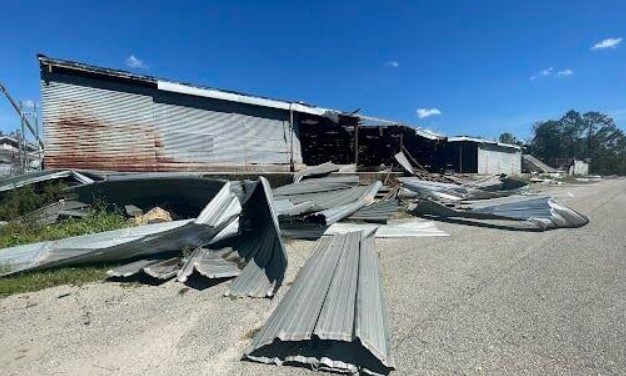By Jim Turner, The News Service of Florida
TALLAHASSEE — Ranchers, farmers and timber growers are reporting widespread damage from the wind and rain of Hurricane Helene, which raced through rural North Florida last week.
Chicken houses had roofs blown off. Acres of sweet corn and carrots were laid horizontal. Irrigation systems have been uprooted. Fences were destroyed by fallen trees. Hay has been left wet and moldy in damaged barns.
Incoming Senate President Ben Albritton, a Wauchula Republican and citrus grower, described conditions in fields across North Florida as “worse” than after Hurricane Idalia in August 2023. Idalia took a similar track, crossed many of the same fields and inflicted more than $400 million in damage to the industry.
But after meeting Monday with growers in Lake City, Albritton said the prevailing view remains “resilient” and “optimistic.”
“I’m telling you, it is encouraging and fascinating, and I see a lot of the same out of North Florida after Idalia last year, after this storm and after Ian, which went across the heartland and up the center part of the state,” Albritton said, referring to 2022’s Hurricane Ian, which made landfall in Southwest Florida.
Gov. Ron DeSantis recently has urged lawmakers to hold a special legislative session to address problems affecting condominium owners.
But Albritton, who will become Senate president after the November elections, said he wants to take a more measured approach.
“Right now, I’m really not contemplating a special session,” Albritton said. “We’ve got a lot of big issues that are floating around, and now we can add Hurricane Helene, and in not just the ag space but all over.”
Agriculture Commissioner Wilton Simpson and Sen. Corey Simon, a Tallahassee Republican who represents a large swath of North Florida, joined Albritton at the meeting Monday.
Simpson described as “catastrophic” the destruction from the Category 4 Helene, which he said affected cattle, field crops, nurseries, beehives and agriculture processing plants. In addition to Idalia, Hurricane Debby also hit the region in August.
“There are no words to describe the devastation to these family farms who have been impacted by multiple storms. Many are still waiting on relief from previous disasters,” Simpson wrote Sunday in a request to U.S. Agriculture Secretary Tom Vilsack for a federal disaster declaration.
“If immediate action is not taken, we are at risk of losing significant agriculture, aquaculture, and silviculture operations in this region due to circumstances beyond our farmer’s control,” Simpson added.
Simpson wrote that in addition to crop and animal losses, fences, barns, honey bee boxes, irrigation systems and farm equipment have been destroyed or rendered useless.
“Riverine flooding is expected to continue well into October, potentially causing additional damage to the agriculture industries,” Simpson said.
Helene had maximum sustained winds of 140 mph when it made landfall late Thursday in Taylor County.
On Friday, Simpson opened a loan program for growers and ranchers who sustained damage in the storm. The program offers interest-free loans up to $500,000 that can be used to repair or replace such things as fences, equipment and greenhouses.
In a November 2023 special legislative session after Idalia, lawmakers approved $75 million for a program that provides low-interest or interest-free loans to agriculture and aquaculture producers, along with $37.5 million to help timber owners.
Hurricane Ian, which barreled across the state in September 2022, inflicted agricultural losses of $1.03 billion, including $247.1 million for citrus growers, $204.6 million for vegetable and melon growers and $195.4 million for the nursery and greenhouse industry, according to the University of Florida Institute of Food and Agricultural Sciences, known as UF/IFAS.
Hurricane Idalia, which made landfall in Taylor County with maximum sustained winds of 115 mph, affected 3.5 million acres and caused production losses of $276 million. Beef cattle, dairy cattle, poultry and aquaculture accounted for $157.6 million of the estimated losses.
When damaged infrastructure and losses sustained by the timber industry were included, a state Department of Agriculture and Consumer Services estimate put Idalia damage at $447 million.
A preliminary report from UF/IFAS released Sept. 19 said agricultural damage from Hurricane Debby, which made landfall Aug. 5 in Taylor County as a Category 1 storm, was estimated between $93.7 million and $263.2 million.
Christa Court, UF/IFAS economic impact analysis program director, said Debby interrupted the planting schedule for vegetables, melons and potatoes.
“They’re just now planting, or just now getting ready to plant, so had the storm happened one to three weeks later than it did, it would be a very different story,” Court told reporters in a conference call when the report was released.

